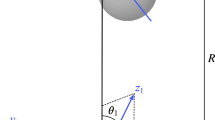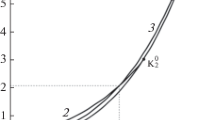Abstract
The isothermal compressibilities KT for cyclohexane + benzene, cyclohexane + toluene and benzene + toluene systems at 25, 35, 45 and 60°C have been used to test the Prigogine-Flory theory using Van der Waals and Lennard-Jones energy potentials. Flory's energy parameter X 12 was calculated for these systems at the four temperatures. From X 12 for the equimolar mixture, the following excess functions were calculated: (∂VE/∂p)T which is related to K ET , the heat of mixing HE, and the excess volume VE. The theory and any of the two potentials give (∂VE/∂p)T which fit the experimental data, but HE and VE, calculated using the same X 12 parameter, depart appreciably from the experimental data even though they agree in sign and have the essential features of the excess functions. The departure is apparent in both magnitude (in particular for the cyclohexane + benzene, and cyclohexane + toluene systems) and in the temperature dependence. The conclusion is that the X 12 parameter does not predict the thermodynamic properties of these systems and the Lennard-Jones potential, involving a more complicated expression, does not contribute any improvement over the Van der Waals potential.
Similar content being viewed by others
References
E. Aicart, G. Tardajos, and M. Diaz Peña,J. Chem. Thermodyn. 12, 1085 (1980).
E. Aicart, G. Tardajos, and M. Diaz Peña,J. Chem. Eng. Data 26, 283 (1981).
E. Aicart, G. Tardajos, and M. Diaz Peña,J. Solution Chem. 11, 557 (1982).
K. Elliot and C. J. Wormald,J. Chem. Thermodyn. 8, 881 (1976).
K. Hsu and H. L. Clever,J. Chem. Thermodyn. 7 435 (1975).
G. H. Cheesman and W. R. Ladner,Proc. Roy. Soc. 229A, 387 (1955).
R. K. Nigam and P. P. Singh,Trans. Faraday Soc. 65, 950 (1969).
A. Nissema and H. Saynajakangas,Finn. Chem. Lett. 129 (1976).
P. J. Flory,J. Am. Chem. Soc. 86, 3507, 3514 (1964).
P. J. Flory,J. Am. Chem. Soc. 87, 1833 (1965);Disc. Faraday Soc. 49, 7 (1970).
A. Abe and P. J. Flory,J. Am. Chem. Soc. 87, 1838 (1965).
R. A. Orwoll and P. J. Flory,J. Chem. Educ. 89, 6814, 6822 (1967).
I. Prigogine,The Molecular Theory of Solutions, (North-Holland Pub. Co., Amsterdam, 1957).
I. Prigogine, N. Trappeniers, and V. Mathot,Disc. Faraday Soc. 15, 93 (1953);J. Chem. Phys. 21, 559 (1953).
L. Tonks,Phys. Rev. 50, 955 (1936).
H. Eyring,J. Chem. Phys. 4, 283 (1936).
H. Eyring and J. O. Hirschfelder,J. Phys. Chem. 41, 249 (1937).
J. O. Hirschfelder,J. Chem. Educ. 16, 540 (1939).
A. Bondi,Physical Properties of Molecular, Liquids and Glasses (New York, 1968).
S. E. Wood and J. A. Gray,J. Am. Chem. Soc. 74, 3729 (1952).
S. E. Wood and A. E. Austin,J. Am. Chem. Soc. 67, 480 (1945).
F. D. Rossini,Selected Values of Physical Thermodynamic Properties of Hydrocarbons and Related Compounds. (API Research Project 44; Carnegie Press; Pittsburgh, Pennsylvania, 1953).
Author information
Authors and Affiliations
Rights and permissions
About this article
Cite this article
Aicart, E., Tardajos, G. & Peña, M.D. Correlation of the prigogine-flory theory with isothermal compressibility data. I. Systems with quasi-spherical molecules. J Solution Chem 12, 41–51 (1983). https://doi.org/10.1007/BF00650711
Received:
Accepted:
Issue Date:
DOI: https://doi.org/10.1007/BF00650711




